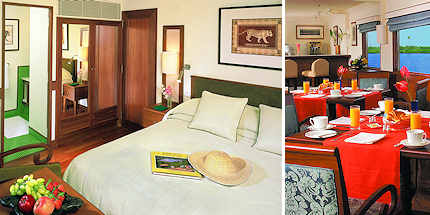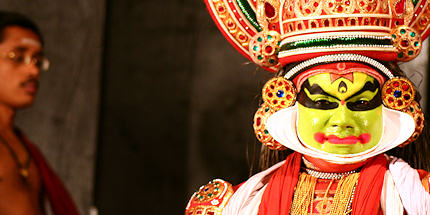Sliding through God's own country
Journey along Kerala’s sleepy waterways in style on the Oberoi's Motor Vessel Vrinda and discover a land so lush and beautiful that it’s known as ‘God’s own country’.
Dressed in fresh pressed uniforms, the staff bustle out in a welcoming flurry to carry my bags on board. Someone hands me a traditional drink of coconut water served in its lumpy green shell. It’s very refreshing - especially after an hour’s drive on a hot and humid afternoon from the nearby port city of Kochi. Pied crows cackle in the palm trees above me and moorhens leap from the quay creating ripples – like a fork through chocolate - in the brown mirror of Vembanad, India’s longest lake.
I’m led up the gangplank and a smiling girl hangs a sweet-smelling necklace of jasmine flowers around my neck. Then I step aboard Vrinda, the superyacht-sized luxury motor vessel that will be my home for the next three days.
 Relax on board the luxurious Oberoi Motor Vessel Vrinda
Relax on board the luxurious Oberoi Motor Vessel VrindaOberoi Hotels & Resorts
Floating idyll
As you’d expect from a vessel created by the hotel chain that has bagged some of the world’s finest awards for luxury travel, the eight-cabin Vrinda is a very stylish craft indeed.
Built from a mixture of noble woods and eco-friendly local materials, the decking and interior finishings are in rich ruby teak wood. With blond bamboo used for fixtures and fittings, and palm fronds providing a shaded canopy on deck, the Vrinda, which bears a fleeting similarity to the far less luxurious kettuvellam rice boats that are generally used for discovering the backwaters, blends perfectly with its surroundings.
From the open deck scattered with comfortable chairs, I’m led through the dining area, with its wall-to-wall windows and well-stocked bar, and down to my stateroom on the floor beneath. I’m expecting to find cramped spaces and porthole windows, so I’m delighted to discover a hotel-sized bathroom and a spacious bedroom with a king-sized bed facing a picture frame window offering panoramic views of Vembanad, the lake that provided the setting for Arundhati Roy's Booker Prize-winning novel, The God of Small Things.
 Ease past traditional kettuvallams on the palm-fringed canals
Ease past traditional kettuvallams on the palm-fringed canalsDesign Pics / Thinkstock
Exploring the backwaters
After a copious breakfast of fresh fruit, coffee and fluffy rice pancakes called idli, I join my fellow passengers – mainly couples from Europe and the US - on deck and we sit back to enjoy the scenery as Vrinda glides across the mirrored surface of the lake into the Alleppey canal.
Extending from canal-studded Alleppey in the south to the coastal resort of Azhikode in the north, Kerala’s backwaters are unique in India. A 900km-long (560 miles) network of lakes, canals and waterways running parallel to the Arabian Sea coastline with a distinctive ecosystem, this wetland is often compared to the American Bayou.
As we putter along the narrow waterway, whose palm fringed edges are studded with plumes of smoke rising from countless copra (dried coconut kernel) factories, kingfishers and cormorants dart out ahead of us, whilst turtles - and once, even an otter - pop up in the water beside us. It’s a blissful antidote to the chaotic bustle of Mumbai where I’d spent the previous week.
Lunch taken on deck is curried pearlspot fish fresh from the lake, followed by brownies oozing hot chocolate sauce. Happily sated, we then swap our luxury vessel for a smaller kettuvellam rice boat that will allow us to explore the narrower canals where the Vrinda can’t navigate.
 Watch colourful Kathakali dancers in Kerala
Watch colourful Kathakali dancers in KeralaCreative Commons / Sriharsha Ganjam
One of the few areas in the world where farming is done below sea level, thousands of people live in Kerala’s backwaters. As we cruise past paddy fields and copra factories, women in vivid coloured saris scrub piles of clothes in the river and young lads duck and dive like seals in the water around them. Above them along the tow bank, little girls with pigtails and wearing neat blue uniforms skip past hand-in-hand on their way home from school.
All afternoon we meander lazily around the waterways, before leaving the boat and striking out along a shaded tow path to visit a Keralan tharavad. It is fascinating to see inside one of these beautiful steep-roofed traditional Keralan houses with its warren of rooms built around a series of flower-strewn, incense-perfumed courtyards.
Snake boats
Glad to be back in Vrinda’s cool dining room after the searing heat outside, we lunch on thali, a succulent local speciality consisting of small heaps of dal, vegetables, rice and chutneys set out on a banana leaf, which we scoop up hungrily using flatbread rotis as forks. After lunch we set off in the rice boat to Chambakulam.
A sleepy fishing village for most of the year, it becomes a riot of life and colour in August during the Chambakulam Moolam, one of India’s oldest boat races, dating back to 1545. Then, dozens of high prowed snake boats, plied by their 100-strong crew, race each other along the sluggish river Pampa. Proudly showing us the village’s own 40m-long (131ft) snake boat, our guide tells us each village has its own boat and that each boat is worshipped like a deity.
 Explore charming Kochi's cobbled streets and temples
Explore charming Kochi's cobbled streets and templesiStockphoto / Thinkstock and Hemera / Thinkstock
From Vrinda to Kochi
I was worried that three days cruising on the back waters could become dull, but our days, which are packed with visits and evenings filled with cultural entertainment, slip by all too quickly. The highlight of our last night is a show of Kathakali, the traditional Keralan dance form where men dress in elaborate robes and masks to act out scenes from the lives of Hindu gods.
Early the following day, the Oberoi’s chauffeur-driven car whisks me to Fort Kochi, an hour’s drive from Lake Vembanad, where I join a tour led by local company Cochin Magic.
The Malabar coast’s main port and once vital hub of the spice trade, Kochi is a charming, dusty cobbled town enlivened by battered ferries zipping back and forth to its islands and to Ernakulam, Kochi’s shop-lined new town. We visit the bazaars selling spices and pashmina shawls in Jew Town, then head for the seashore at sunset to watch fishermen operating the vast Chinese fishing nets for which Kochi is famed.
It’s nice to be back on shore again, but as the sun sets over the tide-torn Arabian Sea, I can’t help missing my luxurious cabin overlooking tranquil Lake Vembanad.
When to go:
Best to go during the mild winters from mid-October to early February or to escape the summer heat from mid-February to mid-May.
Prices:
Greaves of India offers a four day cruise on the MV Vrinda from £1,343pp (two sharing), including all meals and excursions.
Do you have any Feedback about this page?
© 2025 Columbus Travel Media Ltd. All rights reserved. No part of this site may be reproduced without our written permission, click here for information on Columbus Content Solutions.









 You know where
You know where